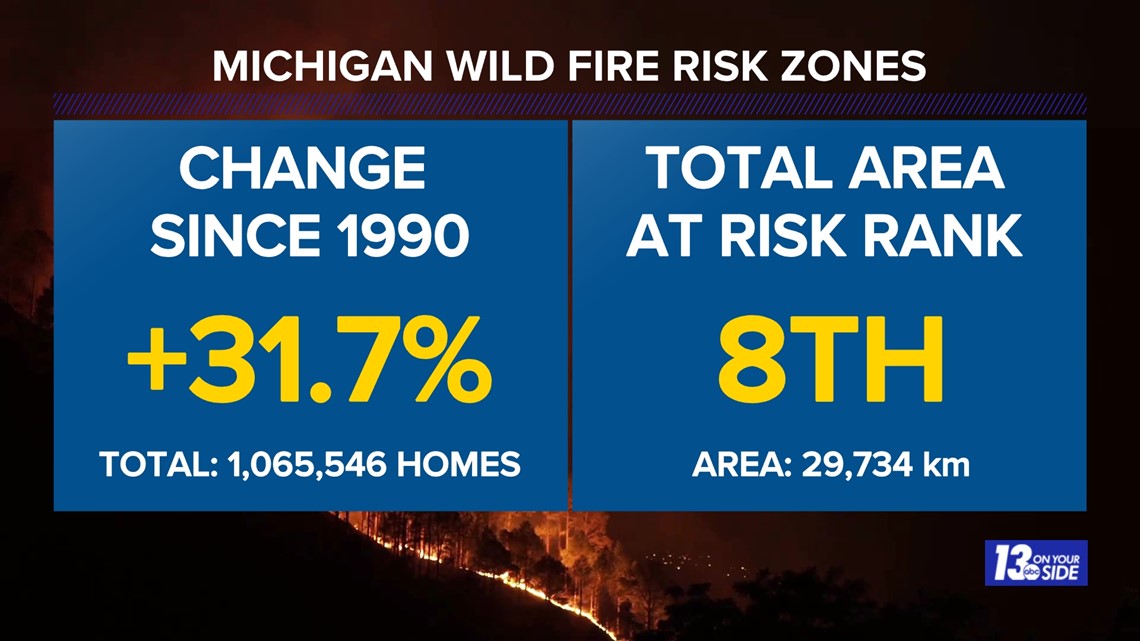GRAND RAPIDS, Mich. — A new study out this week from Climate Central examines how the risk and impacts from wildfires has changed over the last 50 years.
Here in the state of Michigan, we have only seen a slight increase in the number of fire risk days since 1973, but what has significantly changed is the number of Michiganders who are at risk for impacts from the fires that we do have. That's because they live in something called the "Wildland Urban Interface."
This is a region where homes and wooded areas start to closely intermix. In Michigan these regions have grown by over 31% since 1990, leaving us ranked 8th among states in the U.S. for total land area in these zones.


Kaitlyn Trudeau, a senior research associate on climate science for Climate Central told us, "People are moving out into areas where we know, there's a risk here. So instead of moving away from risk, we're moving towards it."
When the fuels for a wildfire end up being so close to your home, the risk for property damage from a fire is going to go up.
Kaitlyn said, "So, in places like that, it increases the risk that you know, if one of these really dangerous fire days occur, and a fire does break out, the risk is just increased. You have much more extreme fire behavior. It's a lot harder for firefighters to put out. It's a lot more taxing on our resources that are already incredibly strained."
Scott Holeman, a spokesperson for the Insurance Information Institute, told us that while most insurance will cover losses from wildfire and wildfire smoke, you should talk to your agent to make sure you fully understand your policy.
Scott said, "What you want to do is have a candid conversation with your insurance professional, you want to make sure you have enough coverage. Do you want to have replacement cost coverage? Do you want it to make you whole or if you're just getting enough to pay cash value. That may not be enough to rebuild."
Scott also gave us the following tips, many backed up by Kaitlyn as well, on how to protect your home from wildfires.
- Maintain five feet of non-combustible "defensible space" around your home.
- Maintain an expanded "defensible space" between five and 30 feet from your home - Keeping this area as unattractive to wildfires as possible will reduce the risk.
- Move trailers/RVs and storage sheds from this area, or build defensible space (see above) around these items.
- Remove shrubs under trees, prune branches that overhang your roof, thin trees and remove dead vegetation.
- Regularly clean off your roof and gutters - to keep debris from being ignited by wind-blown embers. Use noncombustible gutter covers.
- Cover vents and create soffited eaves - Use 1/8-inch mesh to cover vents, and box-in (create soffits) on open eaves to keep embers out.
- Use multi-pane, tempered glass windows - Close windows when a wildfire threatens.
- Remove combustibles from under deck, and maintain effective defensible space around the deck.
- Keep combustibles far away from the house - Combustible structures in the yard such as wood, plastic, or plastic-wood playground equipment should be at least 30 feet away from the house.
- Experts indicate that evergreen trees, palms, and eucalyptus trees have more combustible qualities than others. Keep this type of vegetation 100 feet away from the house.
As climate change continues to impact our planet and our weather, these dangers are not going to go away. Learning to live with these risks and mitigate them will be a necessity as the danger and the number of people at risk both continue to rise.
-- Meteorologist Michael Behrens
Follow me on social media! Facebook Meteorologist Michael Behrens, Twitter @MikeBehrensWX, and Instagram @MikeBehrensWX.
Email me at: MBehrens@13OnYourSide.com
Have a 30-second video or still photo to share? We'd love to share it with everyone! Email your image to Weather@13OnYourSide.com or post it to our 13OnYourSide Facebook Page.
►Make it easy to keep up to date with more stories like this. Download the 13 ON YOUR SIDE app now.
Have a news tip? Email news@13onyourside.com, visit our Facebook page or Twitter. Subscribe to our YouTube channel.

